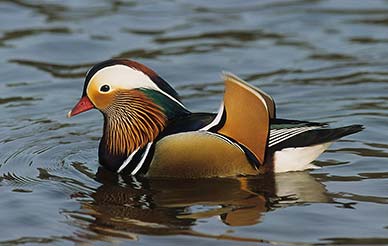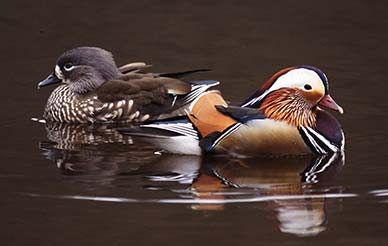Mandarin duck (Aix galericulata)
When: Throughout the year
How many: Relatively small numbers – for example, up to 20 at Eyeworth Pond

Male mandarin ducks are surely the most exotically plumaged of all the New Forest’s birds, an extravagant mixture of cinnamon, orange-chestnut, black and white, topped off by a dark red bill, a flamboyant, multi-coloured crest, prominent orange side-whiskers and equally bright wing-sails.
The female mandarin duck, though, is a much more sober dresser, with simple cloak of grey, brown and white. But whilst cryptic plumage in many female ducks is a huge benefit that helps them remain concealed when nesting on the ground, this is not so for mandarins, for these quirky birds usually nest in tree holes.
Natural cavities are selected in the trunks or branches of broad-leaved trees, often quite high above the ground, and sometimes a number of kilometres away from the nearest water.
The male mandarin duck takes no part in incubation, although he’ll often stay around the nest site, lending moral support whilst his mate sits on the eggs.
Young mandarin ducks – up to a dozen - hatch after around 30 days, and already have a covering of down. Within 24 hours they have the unenviable task of parachuting unaided to the ground. Needle-sharp claws enable them to scramble up the walls of the often quite deep nest cavity, whilst light weight and protective, downy coat helps them survive the journey to earth before the female leads them across country, line astern, to the nearest suitable body of water.
For much of the time, the youngsters stay around the water’s edge, or on adjacent land where they perhaps try to escape the attention of water-borne predators such as pike. The female mandarin duck usually feeds, preens or rests some considerable distance away, seemingly leaving them to fend largely for themselves.

The male mandarin duck is not much help to them, either, as at this time he joins parties of other males and undergoes his annual moult, during which his normal finery is replaced for a number of weeks by female-like eclipse plumage.
Originally introduced in 1928 from Hong Kong, mandarin ducks were used at first as ornamental birds, but small numbers eventually escaped and spread. They were first seen in the New Forest in the early 1960s, but breeding was not confirmed until the early 1980s.
Now mandarin ducks are reasonably widespread in the New Forest, although on the woodland streams, secretive habits often make observation difficult - the first indication of mandarin presence is usually as a pair lift off from the water, calling agitatedly, before weaving their way through the trees and quickly disappearing from sight.
In some well-wooded parts of the New Forest, however, from mid-winter through to early spring, pairs of mandarin ducks are conspicuous at dusk as they fly overhead, calling. Maybe they come in to roost close to prospective nest sites, or maybe they are simply engaging in little-recorded display flights.
References:
The Shell Guide to the Birds of Britain and Ireland: James Ferguson-Lees, Ian Willis and J.T.R. Sharrock
Birds of Hampshire: Hampshire Ornithological Society
Hampshire Bird Reports: Hampshire Ornithological Society
The Birds of the Western Palearctic, Concise Edition: D.W. Snow and C.M. Perrins
Shire Natural History – The Mandarin Duck: Christopher Lever
More links
Other related links
Search this site

Sadly, 58 animals were killed - 35 ponies, 13 cows, 8 donkeys and 2 sheep, whilst a further 32 were injured - 3 pigs, 9 donkeys, 11 cows and 9 ponies.
(Forty-three accidents occurred in daylight, 15 at twilight and 101 in the dark. Twenty-seven accidents were not reported by the driver involved).
Here's just one horrific example - Three donkeys killed in collision with van at notorious New Forest blackspot (Advertiser and Times)

